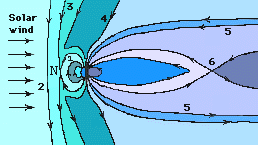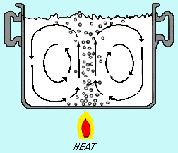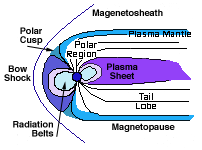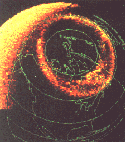Plasma Convection
If tail plasma continually leaks out of the plasma sheet, new ions and electrons must arrive to take its place, or else the plasma sheet would soon be drained and the extended tail field would quickly collapse. How is fresh plasma supplied?
James Dungey's theory of reconnection suggested an answer of sorts. Recall (section on the magnetopause) that in an ideal plasma, ions and electrons that share a field line move together and continue sharing it at all times ("like beads on a wire"). Dungey pointed out an exception to this rule, that when the plasma flowed through a "neutral point" or "neutral line" at which the magnetic force was zero, the plasmas on both sides of that point could become separated and could "reconnect" to different field lines.

Dungey suggested that such a neutral point existed near the front of the magnetopause (marked N on the drawing). He proposed that interplanetary field lines (with the plasma riding on them) linked up there with terrestrial ones, forming compound lines like the one to the right of "3" in the drawing.
That line contains a sharp bend: most of the plasma on the section beyond the bend is interplanetary, most of it on the section closer to Earth is terrestrial. However, both plasmas move together, continue to share the same line, and slowly intermix.
A while later, that line would have moved to position of the line right of "4", then to the position "5", and after that, perhaps half an hour later, the reconnection process would be reversed somewhere downstream of Earth, at a neutral point or line near the number "6". The interplanetary parts are then rejoined and flow away, and the terrestrial halves are reunited too.
Neglecting spill-over at boundary points like the sharp bend in line "3" (and glossing over some important, and as yet not completely understood, plasma physics), one realizes that the above process will transport near-noon plasma, originally earthward of the bend on line "3", to the distant tail. Dungey proposed that the plasma then flowed back earthward, through the plasma sheet.
This would create a steady circulation of plasma in the magnetosphere and would also bring fresh ions and electrons into the plasma sheet, from the vicinity of "6". The process is often named "convection", a name used for circulating flows produced by heat, for instance the flow of water in a heated pot (drawing).

At this point one should look again at the line-sharing property.
If all particles on a field line move together, as tail plasma convects back earthward, the particles on the same field lines but just above the atmosphere must keep up with it. Flows of plasma in that region, consistent with Dungey's prediction, have indeed been observed by probing antennas and by "driftmeter" instruments aboard near-Earth satellites, in orbits that cross the polar regions at low altitudes. The electric field associated with them has also been measured, and for that reason most scientists now support the notion of circulating plasma.
However, in the tail itself the earthward flow has been harder to confirm and seems to be rather irregular, coming in fits and bursts, especially during magnetic substorms. The distant neutral point near "6" is hard to pinpoint using only isolated satellites, and other plasma processes may also play a help break the temporary links between terrestrial field lines (with their plasma) and interplanetary space. "Geotail" observations suggest that this separation occurs about 70-100 RE away on the night side





